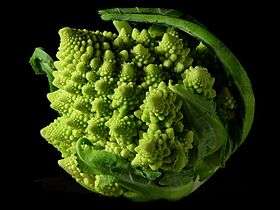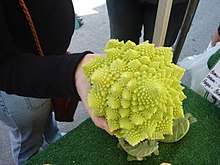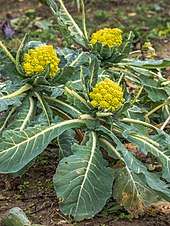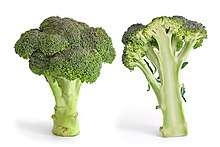Romanesco broccoli
Romanesco broccoli (also known as Roman cauliflower, Broccolo Romanesco, Romanesque cauliflower, or simply Romanesco) is an edible flower bud of the species Brassica oleracea. First documented in Italy, it is chartreuse in color. Romanesco has a striking appearance because its form is a natural approximation of a fractal. When compared to a traditional cauliflower, its texture as a vegetable is far more crunchy, and its flavor is not as assertive, being delicate and nutty.
| Romanesco | |
|---|---|
 Romanesco, showing its self-similar form | |
| Species | Brassica oleracea |
| Cultivar group | Botrytis cultivar group |
The Romanesco has been grown in Italy since the 16th century.
Description
.jpg)


Romanesco superficially resembles a cauliflower, but it is chartreuse in color, and its form is strikingly fractal in nature. The inflorescence (the bud) is self-similar in character, with the branched meristems making up a logarithmic spiral. In this sense the bud's form approximates a natural fractal; each bud is composed of a series of smaller buds, all arranged in yet another logarithmic spiral. This self-similar pattern continues at several smaller levels. The pattern is only an approximate fractal since the pattern eventually terminates when the feature size becomes sufficiently small. The number of spirals on the head of Romanesco broccoli is a Fibonacci number.[1]
Nutritionally, romanesco is rich in vitamin C, vitamin K, dietary fiber, and carotenoids.[2]
Romanesco has a very high content of glucoraphanin.[3]
The causes of its differences in appearance from the normal cauliflower and broccoli have been modeled as an extension of the preinfloresence stage of bud growth, but the genetic basis of this is not known.[4]
See also
References
- Ron Knott (30 October 2010). "Fibonacci Numbers and Nature". Ron Knott's Web Pages on Mathematics. Archived from the original on 28 November 2018.
- Tufts Nutrition. "Tufts Nutrition Top 10". Tufts Nutrition Magazine. Retrieved 26 February 2020.
- Hahn, Christoph; Müller, Anja; Kuhnert, Nikolai; Albach, Dirk (2016-04-27). "Diversity of Kale (Brassica oleracea var. sabellica): Glucosinolate Content and Phylogenetic Relationships". Journal of Agricultural and Food Chemistry. 64 (16): 3215–3225. doi:10.1021/acs.jafc.6b01000. ISSN 0021-8561.
- Martin Kieffer; Michael P. Fuller; Anita J. Jellings (July 1998). "Explaining Curd and Spear Geometry in Broccoli, Cauliflower and 'Romanesco': Quantitative Variation in Activity of Primary Meristems". Planta. 206 (1): 34–43. doi:10.1007/s004250050371.
External links


- Malatesta, M.; Davey, J.C. "Cultivar Identification Within Broccoli, Brassica Oleracea L. Var. Italica Plenck And Cauliflower, Brassica Oleracea Var. Botrytis L.". Acta Hortic. 407: 109–114. doi:10.17660/ActaHortic.1996.407.12.
- Fractal Food: Self-Similarity on the Supermarket Shelf (John Walker, March 2005)
- Procedural fractal 3-D generation of Romanesco broccoli with RenderMan (Aleksandar Rodić, 2009)
